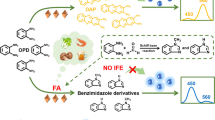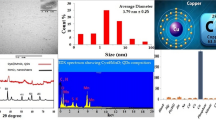Abstract
In the Fenton reaction, ferrous ion acts as a catalyst and reacts with hydrogen peroxide (H2O2) to produce hydroxy radicals (·OH) and hydroperoxy radicals (·OOH). Both have much stronger oxidization ability than H2O2. A fluorescent probe for H2O2 is described here that was obtained by covalent conjugation of carbon quantum dots to gold nanoclusters (AuNCs). The conjugate, under 360 nm photoexcitation, displays dual (blue and red) emission, with peaks located at 450 and 640 nm. When introducing ·OH radicals via the Fenton reaction, the fluorescence intensities of both the CQDs and the AuNCs are decreased. The ratio of the fluorescence at the two peaks is related to the concentration of H2O2 in the 1.25 nM to 10 μM concentration range, and the detection limit is 0.16 nM. The probe was applied to the determination of H2O2 in milk and toothpaste and to cell imaging.

Schematic diagram of the FRET-based fluorescent probe and enhanced performance of hydrogen peroxide detection via Fenton reaction. The fluorescence intensity of CQD-AuNCs nanoaster was decreased as introducing H2O2 to the probe, and can be applied to the determination of milk and toothpaste and cells imaging.





Similar content being viewed by others
References
Li S, Chang K, Sun K, Tang Y, Cui N, Wang Y, Qin W, Xu H, Wu C (2016) Amplified singlet oxygen generation in semiconductor polymer dots for photodynamic Cancer therapy. ACS Appl Mater Interfaces 8:3624–3634
Sheng J, Jiang X, Wang L, Yang M, Liu YN (2018) Biomimetic mineralization guided one-pot preparation of gold clusters anchored two-dimensional MnO2 Nanosheets for Fluorometric/magnetic bimodal sensing. Anal Chem 90:2926–2932
Liu B, Sun Z, Huang PJ, Liu J (2015) Hydrogen peroxide displacing DNA from Nanoceria: mechanism and detection of glucose in serum. J Am Chem Soc 137:1290–1295
Sadhukhan M, Bhowmik T, Kundu MK, Barman S (2014) Facile synthesis of carbon quantum dots and thin graphene sheets for non-enzymatic sensing of hydrogen peroxide. RSC Adv 4:4998
Bai J, Jiang X (2013) A facile one-pot synthesis of copper sulfide-decorated reduced graphene oxide composites for enhanced detecting of H2O2 in biological environments. Anal Chem 85:8095–8101
Chen W, Cai S, Ren QQ, Wen W, Zhao YD (2012) Recent advances in electrochemical sensing for hydrogen peroxide: a review. Analyst 137:49–58
Guler M, Turkoglu V, Kivrak A, Karahan F (2018) A novel nonenzymatic hydrogen peroxide amperometric sensor based on Pd@CeO2-NH2 nanocomposites modified glassy carbon electrode. Mater Sci Eng C 90:454–460
Bag N, Wohland T (2014) Imaging fluorescence fluctuation spectroscopy: new tools for quantitative bioimaging. Annu Rev Phys Chem 65:225–248
Koike S, Kawamura K, Kimura Y, Shibuya N, Kimura H, Ogasawara Y (2017) Analysis of endogenous H2S and H2Sn in mouse brain by high-performance liquid chromatography with fluorescence and tandem mass spectrometric detection. Free Radic Biol Med 113:355–362
Han GM, Li H, Huang XX, Kong DM (2016) Simple synthesis of carboxyl-functionalized upconversion nanoparticles for biosensing and bioimaging applications. Talanta 147:207–212
Yang DP, Guo W, Cai Z, Chen Y, He X, Huang C, Zhuang J, Jia N (2018) Highly sensitive electrochemiluminescence biosensor for cholesterol detection based on AgNPs-BSA-MnO2 nanosheets with superior biocompatibility and synergistic catalytic activity. Sensors Actuators B Chem 260:642–649
Peng Z, Miyanji EH, Zhou Y, Pardo J, Hettiarachchi SD, Li S, Blackwelder PL, Skromne I, Leblanc RM (2017) Carbon dots: promising biomaterials for bone-specific imaging and drug delivery. Nanoscale 9:17533–17543
He W, Gui R, Jin H, Wang B, Bu X, Fu Y (2018) Ratiometric fluorescence and visual imaging detection of dopamine based on carbon dots/copper nanoclusters dual-emitting nanohybrids. Talanta 178:109–115
Gao J, Li Q, Wang C, Tan H (2017) Copper (II)-mediated fluorescence of lanthanide coordination polymers doped with carbon dots for ratiometric detection of hydrogen sulfide. Sensors Actuators B Chem 253:27–33
Zhou R, Li Y, Tian Y, Sun Q, Deng P, Wu L, Hou X (2017) Simple fluorescence sensing of extreme acidity based on inner filter effect of ascorbic acid to fluorescent Au nanoclusters. Nanoscale 9:10167–10172
Zheng J, Zhou C, Yu M, Liu J (2012) Different sized luminescent gold nanoparticles. Nanoscale 4:4073–4083
Chen G, Song F, Xiong X, Peng X (2013) Fluorescent nanosensors based on fluorescence resonance energy transfer (FRET). Ind Eng Chem Res 52:11228–11245
Jin B, Wang S, Lin M, Jin Y, Zhang S, Cui X, Gong Y, Li A, Xu F, Lu TJ (2017) Upconversion nanoparticles based FRET aptasensor for rapid and ultrasenstive bacteria detection. Biosens Bioelectron 90:525–533
Claussen JC, Algar WR, Hildebrandt N, Susumu K, Ancona MG, Medintz IL (2013) Biophotonic logic devices based on quantum dots and temporally-staggered Forster energy transfer relays. Nanoscale 5:12156–12170
Sabet FS, Hosseini M, Khabbaz H, Dadmehr M, Ganjali MR (2017) FRET-based aptamer biosensor for selective and sensitive detection of aflatoxin B1 in peanut and rice. Food Chem 220:527–532
Aron AT, Loehr MO, Bogena J, Chang CJ (2016) An Endoperoxide reactivity-based FRET probe for Ratiometric fluorescence imaging of labile Iron pools in living cells. J Am Chem Soc 138:14338–14346
Zong C, Wang M, Li B, Liu X, Zhao W, Zhang Q, Liang A, Yu Y (2017) Sensing of hydrogen peroxide and glucose in human serum via quenching fluorescence of biomolecule-stabilized Au nanoclusters assisted by the Fenton reaction. RSC Adv 7:26559–26565
Dong Y, Wang R, Li G, Chen C, Chi Y, Chen G (2012) Polyamine-functionalized carbon quantum dots as fluorescent probes for selective and sensitive detection of copper ions. Anal Chem 84:6220–6224
Xie JP, Zheng Y, Ying JY (2009) Protein-directed synthesis of highly fluorescent gold nanoclusters. J Am Chem Soc 131:888–889
Raoof JB, Ojani R, Hasheminejad E, Rashid-Nadimi S (2012) Electrochemical synthesis of Ag nanoparticles supported on glassy carbon electrode by means of p-isopropyl calix[6]arene matrix and its application for electrocatalytic reduction of H2O2. Appl Surf Sci 258:2788–2795
Li BL, Chen JR, Luo HQ, Li NB (2013) Electrocatalytic activity of polymer-stabilized silver nanoclusters for hydrogen peroxide reduction. J Electroanal Chem 706:64–68
Fan H, Zhang S, Ju P, Su H, Ai S (2012) Flower-like Bi2Se3 nanostructures: synthesis and their application for the direct electrochemistry of hemoglobin and H2O2 detection. Electrochim Acta 64:171–176
Wen T, Qu F, Li NB, Luo HQ (2012) Polyethyleneimine-capped silver nanoclusters as a fluorescence probe for sensitive detection of hydrogen peroxide and glucose. Anal Chim Acta 749:56–62
Zhang R, He S, Zhang C, Chen W (2015) Three-dimensional Fe- and N-incorporated carbon structures as peroxidase mimics for fluorescence detection of hydrogen peroxide and glucose. J Mater Chem B 3:4146–4154
Liu Q, Zhang T, Yu L, Jia N, Yang DP (2013) 3D nanoporous Ag@BSA composite microspheres as hydrogen peroxide sensors. Analyst 138:5559–5562
Cui W, Qin H, Zhou Y, Du J (2017) Determination of the activity of hydrogen peroxide scavenging by using blue-emitting glucose oxidase-stabilized gold nanoclusters as fluorescent nanoprobes and a Fenton reaction that induces fluorescence quenching. Microchim Acta 184:1103–1108
Jin L, Shang L, Guo S, Fang Y, Wen D, Wang L, Yin J, Dong S (2011) Biomolecule-stabilized Au nanoclusters as a fluorescence probe for sensitive detection of glucose. Biosens Bioelectron 26:1965–1969
Dasog M, Scott RWJ (2007) Understanding the oxidative stability of gold monolayer-protected clusters in the presence of halide ions under ambient conditions. Langmuir 23:3381–3387
Masanta G, Heo CH, Lim CS, Bae SK, Cho BR, Kim HM (2012) A mitochondria-localized two-photon fluorescent probe for ratiometric imaging of hydrogen peroxide in live tissue. Chem Commun 48:3518
Ju E, Liu Z, Du Y, Tao Y, Ren J, Qu X (2014) Heterogeneous assembled Nanocomplexes for Ratiometric detection of highly reactive oxygen species in vitro and in vivo. ACS Nano 8:6014–6023
Acknowledgments
We thank financially support from Shanghai Science and Technology Committee (17070503000), Shanghai Engineering Research Center of Green Energy Chemical Engineering, International Joint Laboratory on Resource Chemistry (IJLRC), Program for Changjiang Scholars and Innovative Research Team in University (IRT_16R49).
Author information
Authors and Affiliations
Contributions
The manuscript was written through contributions of all authors. All authors have given approval to the final version of the manuscript.
Corresponding author
Ethics declarations
The author(s) declare that they have no competing interests.
Additional information
Publisher’s note
Springer Nature remains neutral with regard to jurisdictional claims in published maps and institutional affiliations.
Electronic supplementary material
Additional experiment sections and methods including characterization of nanoprobe, optimization of detection condition, selectivity and mechanism of the prober, cell cultures were in the supporting information.
ESM 1
(DOCM 2628 kb)
Rights and permissions
About this article
Cite this article
Zhao, Q., Zhou, C., Yang, Q. et al. A FRET-based fluorescent probe for hydrogen peroxide based on the use of carbon quantum dots conjugated to gold nanoclusters. Microchim Acta 186, 294 (2019). https://doi.org/10.1007/s00604-019-3398-5
Received:
Accepted:
Published:
DOI: https://doi.org/10.1007/s00604-019-3398-5




